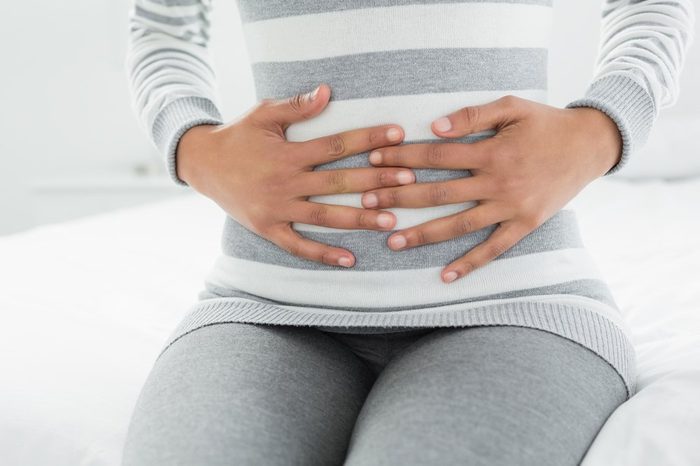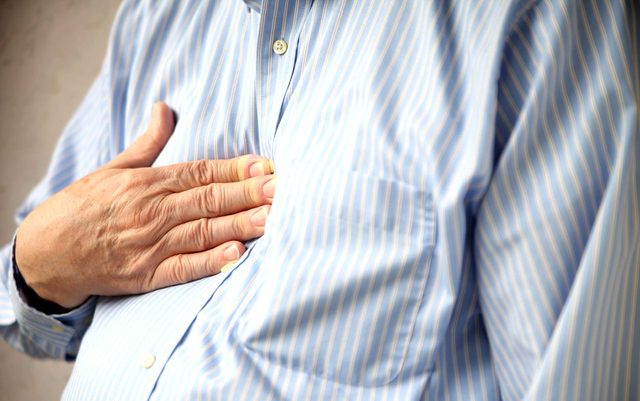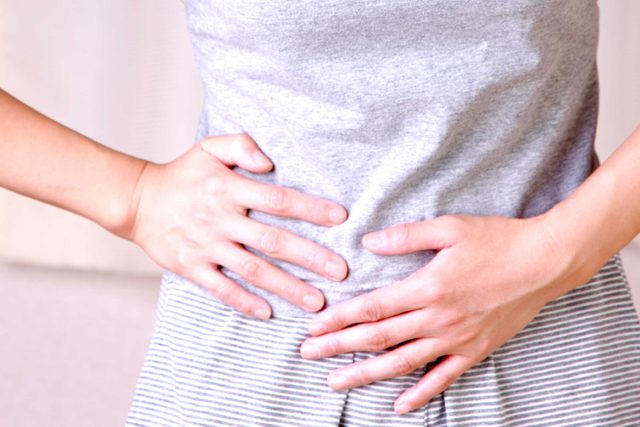
IBS: Cramping in the lower abdomen
If ongoing stomach pain is also accompanied by bloating, gassiness, and a change in bowel habits— either constipation or diarrhea—it could be irritable bowel syndrome (IBS). “IBS is probably one of the most common gastrointestinal disorders that a gastroenterologist sees,” says Lawrence J. Brandt, MD, emeritus chief in the division of gastroenterology at Montefiore Health System. IBS affects about 10 to 20 percent of the U.S. population (mostly women). Though the cause is unknown, some studies suggest that people with IBS (sometimes called “spastic colon”) have an overly sensitive colon or large intestine. IBS shouldn’t cause weight loss or rectal bleeding, says Dr. Brandt. If that happens, something else is going on.

IBD: Abdominal pain and cramping, along with rectal bleeding
These stomach pain symptoms often indicate inflammatory bowel disease (IBD), an umbrella term for conditions that involve chronic swelling in the digestive tract, namely Crohn’s disease and ulcerative colitis. These conditions have similar symptoms, which can make it difficult to diagnose which form of IBD a patient is suffering from, according to the Crohn’s & Colitis Foundation of America. Not to be confused with IBS, IBD is more serious and more rare. While one in five people have IBS, only about one in 200 Americans has IBD, Faten N. Aberra, MD, an assistant professor of medicine in the division of gastroenterology at the University of Pennsylvania in Philadelphia, told EverydayHealth.com. Here’s how to know if your tummy problems are really IBS.

Heartburn: Burning pain in the center of the abdomen
This feeling is all too common after a big, greasy meal: It’s heartburn, and 60 million Americans experience this cause of stomach pain at least once a month. The keyword is “burning,” notes Dr. Brandt, and it’s typically coupled with a bitter taste in your mouth. Acid reflux is the regurgitation of partially digested liquids or foods that have mixed with stomach acid. This acidic mix makes its way into your esophagus (food tube) and throat, causing a burning sensation. Occasional heartburn is nothing to worry about, but chronic heartburn, known as acid reflux or gastroesophageal reflux disease (GERD), can lead to chronic digestive disorders if left untreated. Here’s what everyone gets wrong about the keto diet.

Gallstones: Discomfort around the belly button
If this stomach pain is coupled with dull pain near the shoulder and seems to act up after eating fatty meals, gallstones may be to blame. And if you’re female, older than 40, and have had children, you’re at greater risk. This is because spikes in estrogen, common during pregnancy, may cause gallstones. These tiny stones that form in the gallbladder can go undetected for years and are generally painless unless they get stuck in the cystic duct, explains Dr. Brant. The result: colicky pain, or pain that occurs in cycles. Here’s what you should do if you wake up with stomach pain.

Ulcer: Dull, burning abdominal pain relieved by eating or taking antacids
These are the hallmark signs of a peptic ulcer, along with bloating, burping, poor appetite, and weight loss. Peptic ulcers, or sores on the lining of your stomach or top of your small intestine, affect half a million Americans each year. And despite what you’ve likely heard, they’re not caused by stress. Instead, you can blame one of two major culprits: Helicobacter pylori (or H. pylori), a bacterium that damages the mucous coating of the stomach, or the overuse of non-steroidal anti-inflammatory drugs (NSAIDs) like aspirin and ibuprofen. A routine blood test can detect whether the bacterium is present. Look out for common ulcer symptoms that mean you should see a doctor right away. Don’t miss these medical reasons for lower abdominal pain.

Diverticulitis: Sudden pain in the lower left area of your abdomen
If this stomach pain strikes, along with gas, it may signal diverticulitis, which is an inflammation of small sacks in your large intestine called diverticula. It’s a pretty common GI disorder among older adults. Yet only 10 to 20 percent of people will have symptoms, which include excessive bloating, abdominal pain, cramping, and constipation. Dr. Oz has said, “it’s like having potholes in your colon,” and it’s often the result of too little fiber in your diet. These are the 15 signs your upper abdominal pain might be an emergency.

Appendicitis: Sharp pain in the lower-right side of the abdomen
This kind of stomach pain could spell appendicitis, especially if you have a low-grade fever, are unable to pass gas, feel constipated, or have diarrhea. If you have appendicitis, the pain will likely increase whenever you move around, take deep breaths, cough, or sneeze, and putting pressure on the area will increase your pain. Appendicitis happens when the appendix becomes inflamed and filled with pus, often from an infection. According to the National Institutes of Health, this painful condition is the leading cause of emergency abdominal operations in the U.S. Most often, your appendix will need to be removed before it bursts. Next, beware of the pancreatic cancer signs you might be missing.
